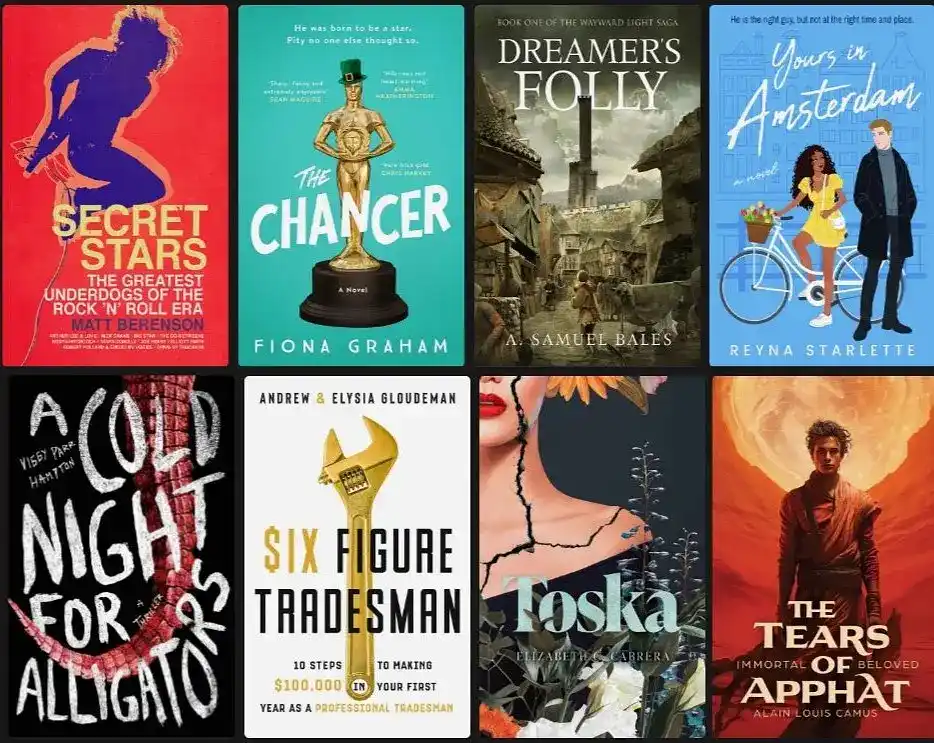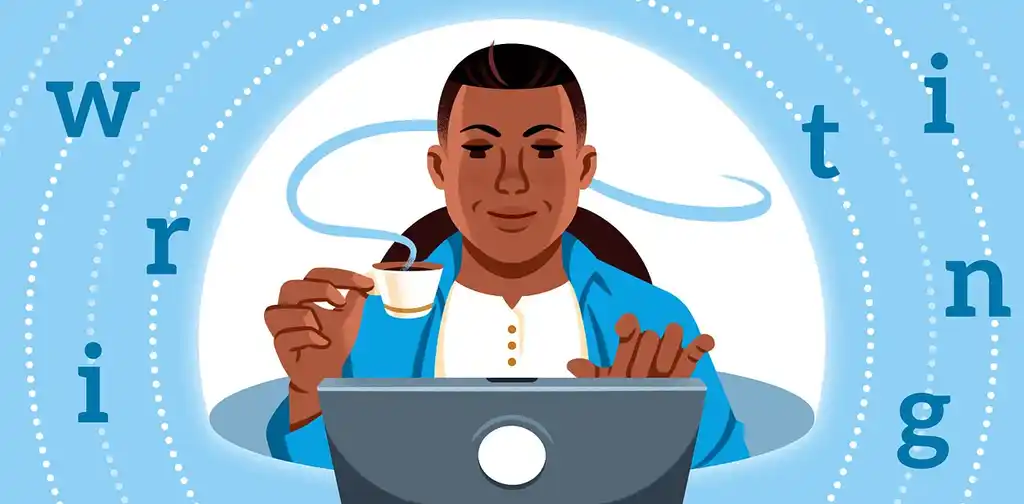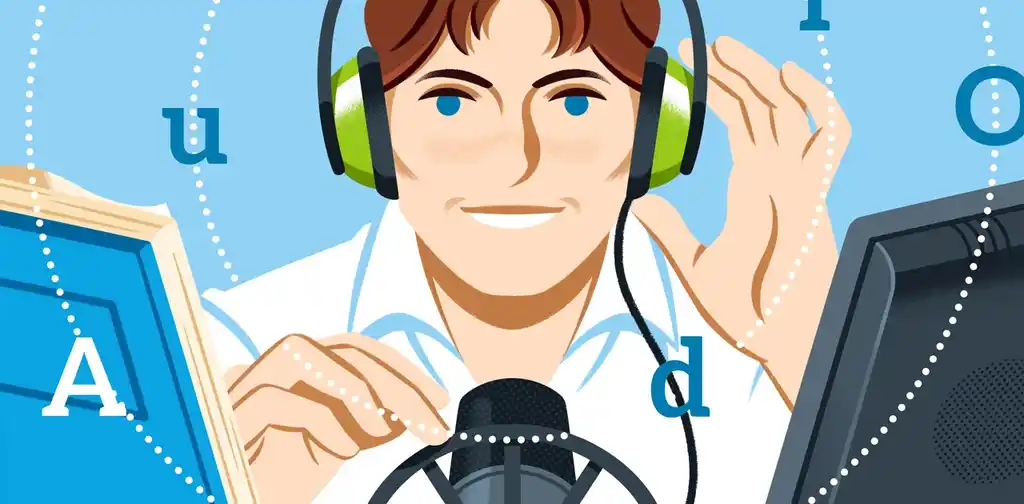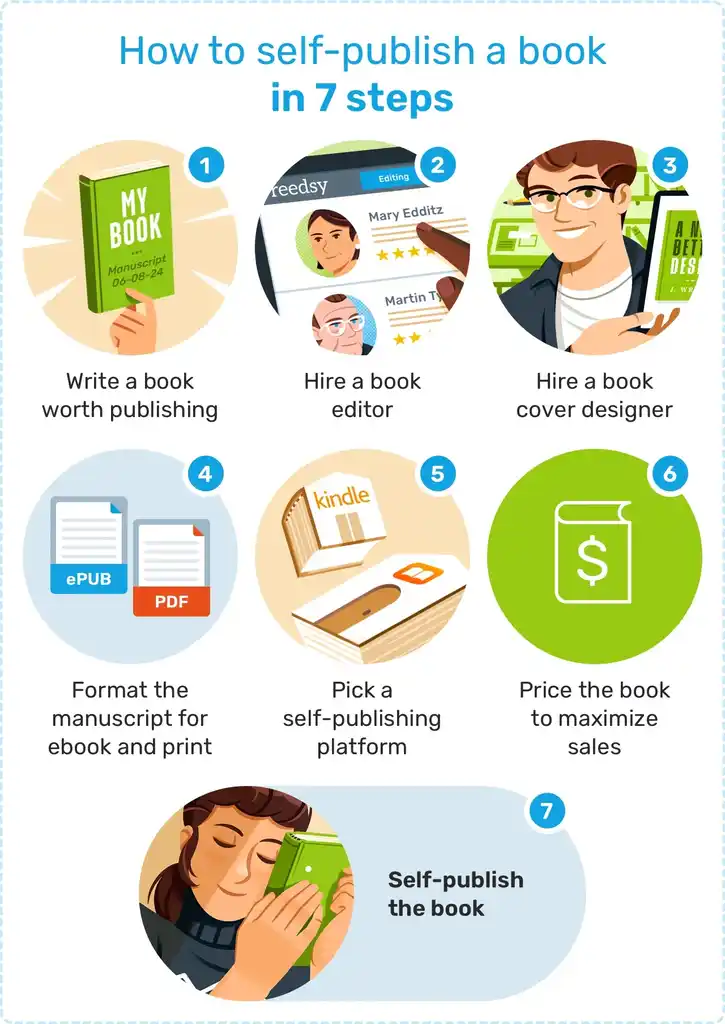Guides • Understanding Publishing
Last updated on Nov 28, 2024
How to Self-Publish a Book in 2025 [+ Checklist]
About the author
Reedsy's editorial team is a diverse group of industry experts devoted to helping authors write and publish beautiful books.
More about the Reedsy Editorial Team →Dario Villirilli
Editor-in-Chief of the Reedsy blog, Dario is a graduate of Mälardalen University. As a freelance writer, he has written for many esteemed outlets aimed at writers. A traveler at heart, he can be found roaming the world and working from his laptop.
View profile →Are you looking to self-publish and join the thousands of authors every year who enjoy complete creative control and a greater portion of royalties?
If so, we're here to show you step-by-step how to get your book out into the world on your terms. To self-publish a book, you need to have first written a quality manuscript. After that, you'll go through editing, cover design, and book formatting before you arrive at the big publication day.
How to self-publish a book in 7 steps:
1. Write a book with market potential
2. Edit your manuscript
3. Get a beautiful book cover
4. Prepare your book’s metadata
5. Select a book distribution platform
6. Price the book to maximize sales
7. Self-publish and promote the book

FREE RESOURCE
Self-Publishing Checklist
Boost sales by checking off the boxes on editing, design, and marketing.
Should you self-publish your book?
Before we dive into the details, let’s address two key questions: should you self-publish your book? And if so, how much will it cost?
Self-publishing offers plenty of perks, such as:
- Complete creative control;
- Higher royalty rates;
- Faster publication timelines; and
- More flexibility overall.
At the same time, indie authors are also responsible for managing every part of the process themselves, often hiring professionals for tasks like editing, design, and marketing. This can be both time-consuming and costly — with the average self-publishing expense ranging from $2,800 to $5,300.
On the flip side, traditionally published authors benefit from full support from a publisher and often receive an advance payment. However, they may spend years navigating the query trenches, pitching to agents, and waiting for a chance to be picked up — only to earn a smaller share of the profits in the end.
Both paths have their pros and cons, so it’s worth taking the time to carefully weigh your options before deciding which route is right for you.
Now, assuming you’ve decided to self-publish, what should your first step be?
1. Write a book with market potential
If you’re here, chances are you’ve either just finished your manuscript or are close to wrapping it up. Either way, it’s crucial to ensure your book has market appeal. You'll want to write a story that’s both fresh and unique, while also staying true to your genre’s conventions and capturing the interests of your target audience.
This can mean:
- Researching bestselling books on Amazon to identify current trends and preferences in your genre;
- Looking for ways to incorporate (or thoughtfully subvert) popular tropes and story structures that resonate with readers; and
- Thinking about how to strike the right balance between the exact story you want to write and what tends to work within your genre.
For more guidance, check out our post on how to write a book, which covers everything from validating your idea to navigating the writing process.
Once you’re confident in your manuscript’s potential, it’s time for the next step: polishing it to near perfection.
2. Edit your manuscript
Experienced authors know that editing isn’t just a tedious box to check — it’s where the real magic happens! It’s the stage where your messy, glorious first draft gets polished into a story that readers will treasure. The editing process happens in different stages:
Self-editing your first few drafts
Before anyone else gets a glimpse of your manuscript, you should aim to refine it as much as possible. For novelists, this means revisiting your drafts to perfect the storyline and ensure your characters feel ‘real’. For nonfiction writers, it could mean tightening up your chapters and re-evaluating how your central message is conveyed.
At this stage, you should also try to eliminate obvious grammar mistakes and typos. Free proofreading tools can help with this cleanup. Don’t worry too much about polishing every sentence to a shine — sentence-level edits will come later in the process. For now, aim to get your manuscript as strong and clean as possible before sending it out.
Getting feedback from beta readers
Having fresh eyes review your manuscript is also invaluable. Share your work with beta readers to receive constructive feedback — and, potentially, with sensitivity readers to get help with spotting cultural inaccuracies and biases. Integrate their suggestions as you see fit.
Hiring a professional editor (or editors)
At this point, you’ll likely want to hire professional editors. Traditionally published books undergo multiple rounds of professional editing before hitting the shelves, and you should aim for the same standard of quality.
There are various types of editing to consider, with the most crucial being:
💪 Developmental Editing: This type of editing focuses on addressing overarching issues in your manuscript, such as structure, plot, and character development, ensuring the foundation of your book is solid. A developmental editor typically highlights areas that need improvements, changes, or cuts — using both individual comments and an overall editorial letter.
📝 Copy Editing: This editor reviews the text line-by-line to correct grammatical errors and punctuation mistakes and resolve any voice or tone inconsistencies. But that’s not all — a copy editor will also enhance your sentences with stronger wording, or restructure them for improved readability. Their goal is to both refine and polish your prose, helping it truly shine.
👀 Proofreading: The final polish to catch any remaining typos or mistakes that may have slipped through during copy editing. Beyond that, a proofreader can also address typographical and layout issues, and crosscheck the text in your front and back matter (e.g., table of contents, foreword, acknowledgments, etc.), ensuring your manuscript is flawless and ready for print.
Depending on what your book needs the most, consider bringing in a professional with tailored editing expertise. On the Reedsy Marketplace, for example, you can search for (and request quotes from) professionals with specific experience in your genre.
Q: When you're self-publishing, what type of editing is a must?
Suggested answer
For self-publishing, an absolute must is copy editing and proofreading. I'd recommend a developmental edit, as well—especially if no one else has read the book—but copy editing and proofing are mandatory to avoid typos, grammatical mistakes, bad sentence structure, etc. A more seasoned writer might not need the Developmental Edit, but even pros can benefit from the copy editing and proofreading. 🙂
Brett is available to hire on Reedsy ⏺
When you’re self-publishing, developmental editing and line editing are crucial steps to consider if you want to put out a professional, high-quality book.
Developmental editing dives into the structure of your story—checking for plot consistency, pacing, character development, and overall narrative flow. It makes sure your story holds together, that characters make sense, and that everything from start to finish engages readers. Without it, even a great concept can fall flat if there are plot holes or confusing elements.
Line editing goes a level deeper, focusing on how your story is told. It improves the clarity, flow, and style of your writing. A line editor will help tighten up sentences, enhance your voice, remove repetitive wording, and make sure every sentence shines.
For self-publishing authors, at least one (preferably both) of these edits are worth the investment. It’s what transforms a good idea into a book that readers can’t put down. Skipping them risks putting out a story that might be inconsistent, awkward, or just not polished enough to compete.
Even if you can only afford one major editing service, try to follow it up with a proofread to make sure it's as polished as possible.
Eilidh is available to hire on Reedsy ⏺
The cost of editing will depend on the service you choose, your word count, your book’s genre, and the freelancer’s experience. For example, for a 60,000-word book, you can expect to pay between $1,000 and $2,000 for most editing services. Try our calculator below to determine how much you’d pay for editing services.
Pricing calculator
Calculate the average cost of editing services for your genre.
Editorial Assessment
Developmental Editing
Copy Editing
Proofreading
Okay — your manuscript has been edited, polished, and proofed. Now it’s time to make sure it looks as good on the outside as it does on the inside!
3. Get a beautiful book cover
Your book cover is your most important book marketing asset and a cornerstone of your overall self-publishing success. In fact, a great book cover can potentially double your sales.
You can design the cover yourself with free cover templates from platforms like Adobe Express and Canva. But a truly effective cover involves more than just aesthetics. It should align with genre conventions, feature strong typography, and follow principles like visual hierarchy. Plus, it requires technical know-how to manage elements like trim sizes, spine width, and back cover design.
If design isn’t your forte, consider working with a professional designer. Reedsy connects authors with experienced designers who can bring your vision to life and handle all the technical details for you. Based on our data, the cost for a professional book cover typically falls between $500 and $800 — a worthwhile investment for a polished, market-ready product.

Q: What impact does a professional cover have on self-published books?
Suggested answer
I think it determines in most cases whether or not the book gets sold. Either consciously or subconsciously. Part of my job as a designer is understanding marketing and trends. I look at book covers, LOTS of book covers. And take notes. Personally I don't think I'd buy a book with an unprofessional cover. If the author didn't take the cover seriously, then what's to say the story is any better? Is this project something they just typed up and published on a whim? Or is it something they really believe in and want to make the best product possible?
Michael is available to hire on Reedsy ⏺
A professional cover plays a huge role in the success of self-published books because it’s the first thing people notice. It gives your book credibility and helps it stand out, making it look just as polished as those from traditional publishers. A great cover not only grabs attention but also sets the tone for your story and appeals directly to your target audience. In a crowded market, it can be the difference between someone scrolling past or deciding to give your book a chance.
Robert is available to hire on Reedsy ⏺
Its an enormous impact. I would say its the single biggest factor in whether your book sells. When I see a cover that looks amateurish, I subconsciously assume that the writing is probably going to be at an amateur level as well. Its as simple as that. I always judge a book by its cover. The book may be the greatest work of the new century but if it is packaged in a way that communicates carelessness or lack of attention then that has huge repercussions for the reputation of the work and the respect that it needs in order to sell. Just go into any book store. Look at the new released that are elegantly designed. You immediately assume that its worth reading because the author, the publishers, everyone deemed it worthwhile to invest time in producing. That assumption is critical in getting your work out to a new audience. Humans are visual creatures. Otherwise, art, advertising, TV, the internet, social media, none of that would need to exist.
Wayne is available to hire on Reedsy ⏺
A professional cover is often the single most important marketing tool for a self-published book. In today's digital marketplace, where readers make split-second decisions based on thumbnail images, a professional cover can mean the difference between a potential reader scrolling past or clicking to learn more. From my experience working with numerous self-published authors, I've seen how a well-designed cover can dramatically improve visibility and sales.
Professional illustration and design bring credibility to self-published works, putting them on par with traditionally published books in terms of visual appeal. This is particularly crucial in online bookstores, where self-published books compete directly with titles from major publishing houses. A professional cover signals to readers that the author has invested in quality throughout their book, from the content to its presentation.
Furthermore, a professionally designed cover and interior illustrations create a complete package that enhances the reading experience and encourages word-of-mouth recommendations. I've seen many cases where striking cover art and quality interior illustrations have helped books gain traction on social media, leading to increased visibility and sales. This professional presentation also opens doors for marketing opportunities and potential partnership deals that might otherwise be unavailable.
Sergey is available to hire on Reedsy ⏺
But don’t forget about the interior
While your book cover plays a crucial role in driving sales, whether that be through ads or as a thumbnail used by online retailers, don't overlook the importance of interior design — which encompasses the page layout and text formatting.
Reedsy has a free book formatting tool with a user-friendly interface that will have your book ready for publication in under an hour. You can simply import your manuscript and effortlessly format headings and paragraphs, insert images and endnotes, create a copyright page, and much more. Read our post on how to format your book with Reedsy’s free publishing app for further info.

FREE FORMATTING APP
Reedsy Studio
Format your manuscript for print or EPUB with a single click.
For books requiring intricate interior designs, such as photography books or cookbooks, you might consider hiring a designer. On average, this service costs between $250 and $750.
Once you’ve taken care of your book’s interior and exterior design, you want to optimize your book’s metadata.
4. Prepare your book’s metadata
Your book’s metadata is essentially all the key information about its content, target market, format, and more. It’s what helps retailers place it “on the right shelves” and show it to the right audience. This metadata also helps potential buyers/readers quickly understand what the book is about and decide whether to pick it up.
Metadata includes details such as the title and subtitle, book description, genre and subgenres, and more. Let’s break down the most important things you should optimize:
Book title
In tandem with the cover design, your title comprises your book's first impression, making it one of the most crucial pieces of metadata to perfect. It should grab readers’ attention, reflect your story’s tone, and resonate with your audience. It should also feel evocative, memorable, and, if you happen to be writing nonfiction, be optimized for Google or Amazon search. For more tips on brainstorming a great title, read our guide on the subject.
To increase your book's searchability, consider playing with its subtitle. For example, if you're writing a romance featuring a specific trope, highlight it in the subtitle (e.g., A Photo Finish: A Small Town Second Chance Romance by Elsie Silver). For nonfiction, you can use the subtitle to outline the topics your book addresses, directly answering readers' questions (e.g., Sex at Dawn: How We Mate, Why We Stray, and What It Means for Modern Relationships by Christopher Ryan and Cacilda Jetha).
Book description
If your title is your one-line pitch, your book’s blurb (150–300 words) is where you close the sale. It appears on your back cover, Amazon page, and more. Here are some tips for crafting a compelling description:
- Start with a gripping tagline. For example, a thriller’s blurb might open with: "A Village, A Murder, A Keen-eyed Sleuth" to create intrigue. A nonfiction book, like Ricardo Fayet’s How to Market a Book, starts with “Writing a book is hard. Marketing it can be even harder” — addressing an author’s pain-point head on.
- Highlight notable mentions or reviews. If a magazine or another author has praised your book, include their quote to build credibility.
- Consider using bullet points. Again, especially for nonfiction, you might list what readers will learn or take away. Check out Ricardo’s book for a good example of this.
- Make use of formatting tools. Use bold or italics to ensure the most important details stand out, and separate your text in paragraphs to make it easier to read.
For more advice, read our post on how to write an Amazon book description.
Categories (BISAC Codes)
Another important piece of information is your book’s BISAC codes. These codes classify your book’s genre and categories, making it easier for retailers to categorize and readers to find. You can look them up on the official Book Industry Study Group site, but when uploading your book to Amazon or other platforms, you’ll typically select them from a provided list.
When choosing categories, be strategic. Usually, it's good practice to select one broad category (e.g., Romance) and one specific niche (e.g., Sports Romance). For keywords, pick mostly terms not already in your title or description. This helps expand your book’s discoverability by covering a wider range of potential search queries.
ISBN number
While you don't need an ISBN number to publish your book, you may still want to purchase one. Owning your ISBN allows you to register yourself as the book’s publisher, giving you full control of your publishing rights across retailers. Note that if you plan to release multiple formats (e.g., ebook, paperback, audiobook), each format will require its own ISBN.
On Bowker, a single ISBN costs $125, but you can save by purchasing a bundle of 10 for $295. For more details, check out our guide on how to get an ISBN number.
Overall, optimizing your book’s metadata is essential for a proper book launch. This is why many authors work with specialized marketers to refine their blurbs, select effective Amazon keywords, and enhance their book’s visibility across all platforms.
🧙🏼♂️ Hire a marketing wizard on Reedsy.
Michal S.
Available to hire
I run Amazon ads for authors who don't have time or headspace to do that by themselves. Dozens of satisfied customers and 150k+ copies sold.
Brian B.
Available to hire
I 've helped hundreds of authors manage their Amazon and BookBub Ads campaigns
Kate L.
Available to hire
10 yrs marketing experience in consulting, launching, and promoting books. Specialized in sci-fi, fantasy, gamelit/litrpg, spec fic, LGBTQ+
🤔 Do I need to set up a company (LLC) to self-publish a book? No — but it can be beneficial if you want to protect personal assets from legal risk (e.g., if you write a memoir), establish a bigger professional brand, or scale your publishing career overall. That said, for most first-time authors, starting without an LLC is fine.
The next step is to choose a distribution platform and prepare the files to upload.
5. Select a book distribution platform
Next up, to get your book into readers' hands, you'll need to pick a distribution platform. First, decide whether you want to offer your book as an ebook only or as both an ebook and a print edition.
If you go the ebook route, you have two main options:
- Distribute it directly through online retailers (keeping all the profits); or
- Use an aggregator to quickly publish your book across multiple platforms (but they’ll charge either a percentage of your sales or an upfront fee).
If you also want to print your book, then you’ll need to evaluate the best print-on-demand services. The two largest services in the world are Kindle Direct Publishing (KDP) and IngramSpark. Both let you upload your book and list it on their platforms for free, and they also provide comparable book products at similar printing and shipping costs.
Here’s a quick overview of the most popular book distribution platforms:
|
Platform |
Type |
Royalties |
Notable features |
|
Amazon Kindle Store |
Distributor |
70% for ebooks priced $2.99-$9.99; 35% outside this range |
Largest ebook retailer; access to Kindle Unlimited through KDP Select program |
|
Barnes & Noble Press |
Distributor |
70% for ebooks priced above $0.99 |
Integration with NOOK devices; potential in-store availability in B&N bookstores |
|
Apple Books |
Distributor |
70% on all ebooks, regardless of price |
Pre-installed on Apple devices; no exclusivity requirements |
|
Kobo Writing Life |
Distributor |
70% for ebooks priced $2.99 and higher; 45% below |
Strong international presence; promotional opportunities through Kobo Plus |
|
Google Play Books |
Distributor |
70% on all ebooks regardless of list price |
Integration with Android devices; global reach through Google Play Store |
|
Draft2Digital |
Aggregator & POD Service |
Takes 15% of net royalties |
Distributes to multiple retailers; offers free formatting tools and Universal Book Links |
|
PublishDrive |
Aggregator |
Subscription-based service (starting at $16.99/month) |
Distributes to over 400 stores and 240,000 libraries; detailed sales analytics |
|
KDP Print |
POD Service |
50%-60% of list price minus printing costs |
Excellent for Amazon sales; limited outside distribution |
|
IngramSpark |
POD Service |
45%-70% of list price minus printing costs |
Extensive global distribution network; access to bookstores and libraries |
For more details on each service, check out our complete guide to ebook distribution. You can also read our post where we tested and reviewed all the major print-on-demand (POD) book services.
Prepare your files with a formatting tool
Each service has slightly different requirements for file upload, but in general, you’ll need an EPUB file for the ebook version and a PDF file for print. As mentioned earlier, you can get both types of files for free using Reedsy Studio. Once you’re happy with how you’ve formatted your book, identify the trim size you need and simply export the files!
For the cover design, if you’re working with a professional, just let them know which platform(s) you want to use to print your book and they’ll take care of the details. If you’re making the cover on your own, read about the platform requirements for file upload and follow them carefully.
A word on audiobooks
The audio format has skyrocketed in popularity, and many self-published authors have invested in audiobooks and reaped the benefits. If you want to take advantage of the audiobook market, check out our guide on how to make an audiobook as an indie author. You’ll also find all the important details to know about how to create and distribute your audiobook files.

FREE COURSE
Audiobook 101
Learn to create a professional audiobook and stand out in a growing market.
Before you hit the publish button, there’s one more crucial thing to discuss: your book’s price.
6. Price the book to maximize sales
Setting your book price is a delicate balance. If you price it too high, you will profit more with every copy sold, but you may sell far fewer copies. Similarly, underpricing a book may sell more units but leave you with less money at the end of each month. So how should you price your work?
Research your market
The first prerequisite to setting your book’s price is to know your market inside out. What is considered a “normal” price for a book like yours? You can find that out by perusing the bestseller lists in your genre and looking at their prices.
Ricardo Fayet, author of How to Market a Book, points out that for many years, traditional publishers have been voluntarily overpricing ebooks in an effort to protect their print sales:
"You can’t really trust the prices of famous, traditionally published ebooks in your genre. Instead, look for high-selling titles from independent authors in your genre, and use those as a benchmark."
Needless to say, when pricing a book that you’re publishing yourself, you have the capacity to make the pricing decision that is best for you — without the external involvement of a publisher.
Lower your price to build your fanbase
As part of your wider strategy, Ricardo also mentions that a low price can be a great tool to entice readers to take a chance on your book.
“While you can certainly mimic the prices of the most famous indie authors in your category, it can also be a good idea to price your books a tad lower as a start, just to start building that fanbase.”
Once you have an established readership, they’ll have no problem paying more to get your future releases. And once you have multiple books in your back catalog, your pricing tactics can get a bit more sophisticated.
For a series, adopt a staircase pricing strategy
The most successful self-published authors are usually the ones who write one or more series. One reason for this is that it only requires the author to heavily market the first book in the series. If the reader likes that first book, they will then be inclined to buy the next book (and perhaps even pay more for it).
With a series, Fayet suggests starting with a free (or heavily discounted) ebook and then progressively raising the prices as readers get deeper into the series.
"For example, you could offer book one for $0.99, book two for $2.99, book three for $3.99, and the rest of the books in the series for $5.99. Once a reader is invested in your series — and absolutely needs to know what happens next — pricing is not as big a factor in their purchasing decision."
To learn more about using price promotions to boost your sales and ensure your publication is priced correctly in all countries, check out Reedsy’s free course on pricing books for an international audience.
Q: What's the most common mistake authors make when pricing their self-published books?
Suggested answer
A big mistake I see authors make is not thinking through how their pricing affects readers. If you price your book too high, you risk scaring people off. If it’s priced too low, readers might assume it’s not worth their time. Finding the right balance—what I like to call the “sweet spot”—is so important.
The best place to start is by looking at other books in your genre. What are they priced at? This gives you a good idea of what readers are willing to pay. Temporary promotions, like dropping your price to $0.99, can help boost visibility, but I don’t recommend staying there. It’s easy to get caught in a “race to the bottom,” where constant discounts make your book feel less valuable.
As your book gains credibility—through reviews, awards, or just word of mouth—you can raise your price to reflect that value. Pricing isn’t just about numbers; it’s about showing readers that your book is worth their time and money.
Jd is available to hire on Reedsy ⏺
The most common mistake authors make when pricing their self-publishing books is not pricing it so that they are covering all of their outlaid costs. Some authors only look at comparative titles in the marketplace and how they are priced. Indeed, this is an important step in figuring out what to price a book, but if you are not making a return on investment to at least to recoup your spend, not to mention a profit, then your list price is failing you.
Tara is available to hire on Reedsy ⏺
7. Self-publish and promote the book
Now that you’ve exported your book and uploaded it to your retailer of choice, all that's left is to pull the trigger and... congratulations, you’ve published your book!
However, if you want to give it the best chance to thrive on Amazon and other platforms, you’ll need a proper book launch. A lot hinges on a book’s first few weeks on the market 一 your title must accumulate a healthy dose of book sales and reviews right away.

FREE RESOURCE
Reedsy’s Book Launch Checklist
Launch your book successfully with our tried-and-true strategies.
Note that, while this is technically a post-publication step, it's important that you create an effective and timely book publicity plan weeks in advance. It takes some to plan PR activities like reviews, interviews, live readings, and podcast appearances. With that in mind, read on for a few key steps to consider.
Get book reviews
One of the key elements of sales is gathering social proof 一 people who read your book and (hopefully) give it a positive review. There are several ways to get book reviews — you could:
- Ask book bloggers to review your work;
- Send ARC copies to your friends, followers, and other potential readers; or
- Pay $50 for a high-quality review on a site like Reedsy Discovery.
For more advanced tips on how to get reviews on your Amazon’s book page before your launch day, read this post!
Keep marketing your book
Promoting your book is a long-term commitment. After publication, use analytics tools to measure how well your marketing strategies are working. Track key metrics like sales at different price points or click-through rates on ads, and adjust your strategy accordingly.
Beyond tracking data, get creative! There are countless ways to market your book, from joining #BookTok to hosting live readings and more. If you’re looking for inspiration, we’ve compiled over 70 book marketing ideas in another post — perfect for diving deeper into your promotional strategy.
Curate your author website and newsletter
Another cornerstone of book marketing is having a professional author website, which includes your author bio, book pitch and buy links, and other promotional information. Ideally, you should build an email list and nurture your readership over time — before and after you publish the book.
Get involved in the indie community
Finally, remember that while self-publishing is an entrepreneurial journey, you don’t have to go it alone! Engaging with the indie author community can provide valuable insights and inspiration along the way.
One of the easiest ways to start is by thoughtfully interacting with fellow authors on social media. If you’re looking for more hands-on strategies, consider joining online writing communities, building your own street team, or attending writer’s retreats and conferences. These connections can make your self-publishing journey more rewarding and collaborative!
By following the steps outlined in this post, you won’t just publish your book — you’ll give it the best possible shot at success. Who knows? You might even become the next big success story in the world of self-published authors. Good luck!


